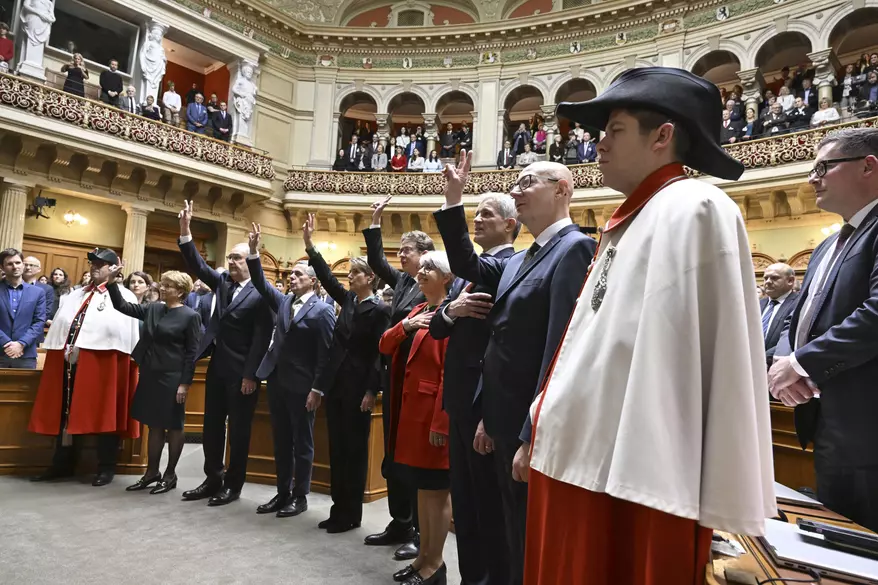SWISS FEDERAL COUNCIL SYSTEM HAS A NUMBER OF ADVANTAGES
The U.S. and the world are at great risk because the president has some cognitive impairment and the vice president is unqualified. The fundamental problem that is too many responsibilities and too much power are now invested in one person.
When George Washington became the first president in 1789, the federal government was tiny. The first federal budget was drafted by the first secretary of the treasury, Alexander Hamilton, by himself in his own hand. Washington had a number of important decisions to make, and Hamilton, being exceptionally smart and able, was able to draft the budget without a big government bureaucracy to contend with. Today, the president has a couple of dozen people of Cabinet rank and a couple of dozen other officials reporting directly to him. No executive can manage that many people, let alone read all of the documents a president is supposed to be familiar with and approve, while performing all of the ceremonial functions. In sum, the job of the U.S. president is impossibly large, even for the most able person.
It should be obvious that fundamental structural change is needed. Are there role models in other countries that the U.S. might emulate? Most countries separate the functions of “head of state” from “head of government” by having both a president and a prime minister. Britain and some other countries have a king as head of state and a prime minister as head of government. The separation of head of state and head of government only partially solves the problem of “span of control” (too many people reporting to one person) and the problem of what to do if either party is incapacitated.
The Swiss may have created the most functional solution when it comes to design of government. Switzerland, despite being landlocked and having few natural resources, has managed to create one of the richest and peaceful places on the planet. Crime in Switzerland is a tiny fraction of that in the U.S. The Swiss have not been in a war with a foreign country since 1815, and their last civil war was in 1847 — which lasted about three weeks and killed only about 100 people before they decided it was a bad idea and all went home. The Swiss have strong protections for property rights and civil liberties, and little corruption. They also have world-class educational and medical systems. Some Swiss cantons (states) have very low taxes and small government (e.g., Zug), and others have higher taxes and more government (e.g., Geneva), giving citizens a wide choice.
If you don’t know who the Swiss president is (Viola Amherd), most Swiss don’t either, because he or she serves for only a year. The presidency is in effect made up of the seven members of the Federal Council and rotates among them. Each of the Federal Council members heads up a government department. Major decisions are made jointly, and the entire Federal Council is the collective head of state. The Swiss president is elected from the Federal Council by Federal Assembly — which is made up of both branches of the legislature.

The newly composed Federal Council gesture, during the swearing in ceremony, from left Viola Amherd, Guy Parmelin, Ignazio Cassis, Karin Keller-Sutter, Albert Roesti, Elisabeth Baume-Schneider, and the newly elected Beat Jans and Federal Chancellor Viktor Rossi, flanked by Councillor Antoine Maillard, right, and Councillor Mario Gonzalez, left, following Federal Council general election by the United Federal Assembly, in Bern, Switzerland, Wednesday, Dec. 13 2023. (Peter Schneider/Keystone via AP)
The Swiss Federal Council system has a number of advantages in that it minimizes the “cult of the presidency,” which is all too common in most countries, including the U.S. It dampens reckless behavior and protects the country from instability stemming from incapacity from one of members of the council. It reduces the power of the executive branch, thus doing a better job in protecting economic and civil liberties.
The Swiss have combined the Federal Council system with “direct democracy” for all major questions. Major issues require a vote by the citizens at large, coupled with a vote by the individual cantons. To understand how it would work in the U.S., imagine there were a proposal to reinstitute the draft. The measure would be put in a referendum for all voters, plus a vote by the individual state legislatures — and for it to be implemented, both a majority of the citizens and the state legislatures would need to vote in the affirmative. This system enabled the Swiss to put in a constitutional measure to limit the growth in government spending, which has led to a sound fiscal and monetary system.
The Swiss took the U.S. Constitution as their model but made major revisions and improvements to it in 1848. Perhaps it is time for the U.S. to return the favor by adopting some of the Swiss improvements.
It would take a constitutional amendment to change the system from a unitary to a collective presidency, and the obligations and limitations of each of the members of the Federal Council would need to be detailed. In addition, the election and removal system for members of the council would need to be specified.
Once implemented, most people initially would hardly notice the change. Government offices would operate much as they have always done. But over time, the risk of misgovernance would be reduced, leading to greater freedom and prosperity.
• Richard W. Rahn is chairman of the Institute for Global Economic Growth and MCon LLC.
https://www.washingtontimes.com/news/2024/feb/12/collective-presidency-would-reduce-risk-of-misgove/
© Copyright 2024 The Washington Times, LLC.